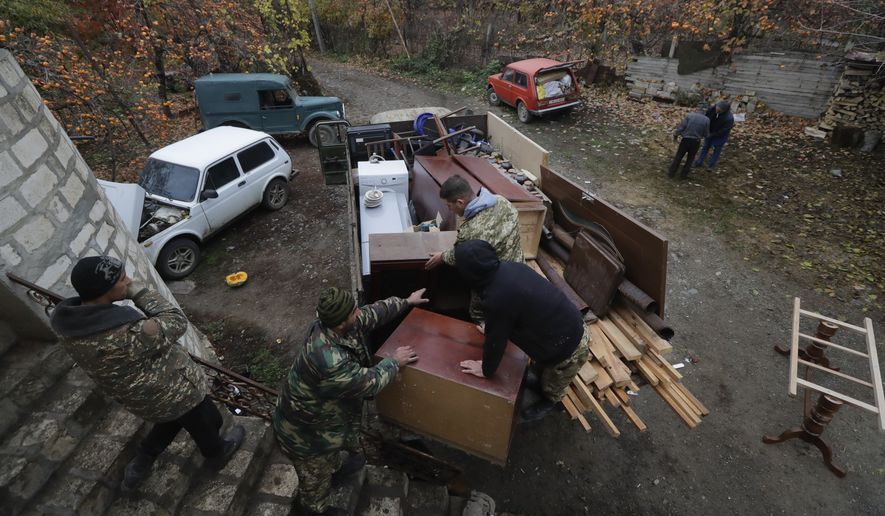OPINION:
For the first time in history, a war has been won almost entirely by unmanned aircraft — by what are technically called “armed drones” or Remotely Piloted Vehicles (RPVs) and Unmanned Aerial Vehicles (UAVs, guided autonomously).
On Nov. 10, Armenia surrendered to Azerbaijan, ceding control of the disputed enclave Nagorno-Karabakh located within Azeri territory. Nagorno-Karabakh borders Armenia, has a predominantly ethnic Armenian-Christian population that, together with Armenia, has fought to resist domination by predominantly Muslim Azerbaijan.
The Nagorno-Karabakh War has flared on and off for some 30 years, a long stalemate little noted in the Western press.
But now the decisive defeat of Armenia by futuristic RPVs portends a revolution in military technology akin to the invention of gunpowder or the use of manned aircraft in World Wars I and II that changed the dimensions and nature of warfare.
The Azeris made no significant use of manned aircraft to defeat Armenia.
Armenia has a manned air force, comprised mostly of Russian-built Su-25 ground attack and Su-30 jet fighters. Armenia’s armed forces have Russian-built tanks, including T-80s and T-76s, other armored fighting vehicles, artillery, and sophisticated SA-15 and SA-10 air defense missile systems.
Azerbaijan broke 30 years of military stalemate and triumphed decisively using an unmanned air force.
“This conflict will become another case study on the vulnerability of land forces where air power can be applied without hindrance. Another Turkey shoot for the textbooks,” according to strategist Carlo Kopp, an expert in military technology.
Azerbaijan’s Bayraktor Tactical Block 2 (TB-2) remotely piloted warplane, similar to the U.S. Predator, did most of the damage to Armenia’s armed forces. The TB2 was helped by Harpy-2 unmanned loitering munitions and Spike anti-tank guided missiles.
The TB2 and other RPVs and UAVs were virtually invisible to Armenian air defenses. Their small size, largely plastic composition and slow subsonic speeds make them almost undetectable to sophisticated air defense missiles and radars designed to intercept larger supersonic manned aircraft—achieving “stealth” on the cheap.
Armenia’s material losses: 138 tanks, 49 armored fighting vehicles, 167 howitzers and other towed artillery, 90 multiple launch rocket systems, 31 air defense missiles, 16 radars, 386 trucks and jeeps, and 89 military buildings and munitions depots.
Armenia’s “Pearl Harbor” will be another case study in technological surprise. Mr. Kopp: “The Armenians did not appear to understand what they were dealing with.”
I eye-witnessed the beginning of the Nagorno-Karabakh War during the late-1980s, when then-Soviet Premier Mikhail Gorbachev’s attempted “glasnost and perestroika” reforms naively presumed that communism and the USSR could be maintained without brute force.
Previous Soviet regimes crushed ethnic and religious conflicts with the Red Army and kept their glowing-embers from flaring-up with KGB terror. Almost as soon as Mr. Gorbachev loosened the Soviet iron fist, Armenians and Azeris started fighting over Nagorno-Karabakh.
I was on a business trip that took me from Yerevan, Armenia’s capital, to Azerbaijan’s capital, Baku. Azeri baggage handlers and travelers waiting at the station had to be told not to attack us, that we were not the enemy, just because we were arriving from Armenia.
We were not harmed, but the Azeris had knives in their eyes.
The Nagorno-Karabakh War has been a conflict between peoples and religions, deeply rooted in hatreds as old as the Islamic conquests and Christian crusades of the medieval era, now fought with 21st century weapons.
Armenia’s defeat has enraged the populace and destabilized the government. Mass protests are calling for the resignation of Prime Minister Nikol Pashinyan. Ethnic Armenians are fleeing Nagorno-Karabakh, reportedly using scorched earth tactics to leave nothing of value for the Azeris.
Beyond the human tragedy, the little known Nagorno-Karabakh War has some profound strategic implications for the United States.
Russia, an ally of Christian Armenia against Islam since the days of the Ottoman Empire, could have intervened militarily and decided the war in Armenia’s favor, and was expected by Armenia to do so. Instead, Moscow intervened diplomatically to end the war in favor of Azerbaijan and their backer — Turkey.
Russia has handed Turkey a “win” highly significant for Ankara and Prime Minister Recep Tayyip Erdogan’s aspirations to lead the Islamic world — no doubt as part of Moscow’s strategy to lure Turkey away from NATO.
Turkey and NATO are already at odds over Ankara’s warming relations with Russia, including recent purchases of advanced Russian military equipment and collaboration with Russian military technical advisers.
Turkey plays a crucial role in the defense of NATO, containing Russia’s Black Sea Fleet and having the second-largest NATO army, after the United States. If Turkey leaves NATO for neutrality or alignment with Russia, NATO may become indefensible.
Moreover, Turkey manufactures and supplied the TB-2 that gave Azerbaijan victory. Israel makes the Harpy-2 and Spike.
Thus, the military revolution in unmanned airpower does not depend upon the U.S., Russia or China. Much smaller, less sophisticated nations, like Azerbaijan (militarily ranked 64th in the world by GlobalFirePower.com) can arm themselves with “flying killer robots” and perhaps become giant slayers.
Is the U.S. Global Policeman, like the proud French Knights at Agincourt, riding toward a rendezvous with technological surprise?
• Peter Vincent Pry, director of the Task Force on National and Homeland Security, served as chief of staff on the Congressional EMP Commission, and on the staffs of the House Armed Service Committee and the CIA. He is author most recently of “The Power And The Light” (Amazon.com).




Please read our comment policy before commenting.